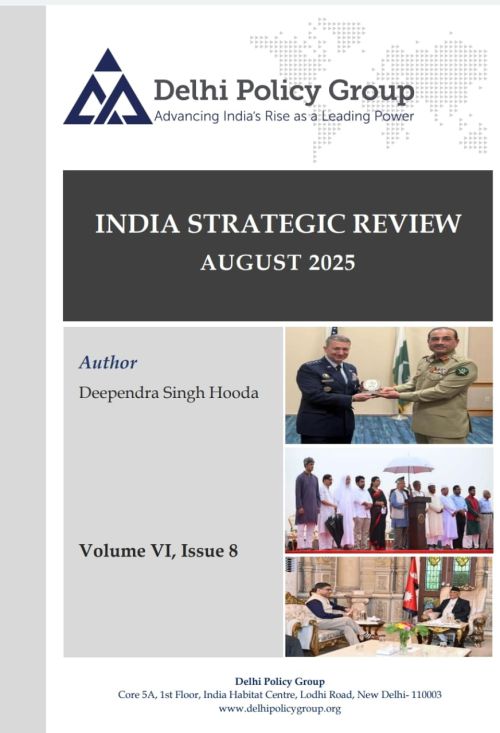India Stretegic Review
The ISR features an assessment of key developments, trends, and policies pertaining to India’s immediate and continental neighbourhood and is authored by Lt. Gen. Deependra Singh Hooda (Retd.), Distinguished Fellow for Military Strategy.
US-Pakistan ties continued their warming trend as the two countries concluded a trade agreement cutting the tariff on Pakistani goods to 19%, down from a previously signalled 29%. Pakistan Army Chief Field Marshal Asim Munir paid his second visit to the US in two months, where he drew criticism for his incendiary nuclear threats and anti-India remarks.
During his visit to Pakistan on August 21, Chinese Foreign Minister Wang Yi promised an “upgraded” CPEC 2.0 across five thematic corridors and pressed for greater protection of Chinese projects. Continuing with its procurement of Chinese military equipment, Pakistan inducted Chinese Z-10ME attack helicopters and the third Hangor-class submarine into service.
To counter the growing militant violence in Pakistan, its army launched Operation Sabakaf in Khyber Pakhtunkhwa. In Balochistan, Section 144 was imposed throughout August, and mobile internet services were shut down. However, there was little impact, as terror attacks continued.
Afghanistan entered its fourth year under the Taliban, with a widening de facto acceptance of the regime. Rule of the Taliban is by exclusion, as women are pushed out of education, work and public life, and minorities like the Hazaras face targeted persecution. Media freedom has collapsed under sweeping censorship.
Humanitarian pressures have intensified in Afghanistan due to the surge of returnees from Iran and Pakistan, and a massive earthquake that hit the country’s remote eastern areas on August 31. International support has dwindled after the US, the largest donor, decided in April 2025 to suspend all aid to Afghanistan.
China’s Foreign Minister Wang Yi paid an official visit to India on 18-19 August. During his meeting with National Security Advisor Ajit Doval, the two sides agreed to set up expert and working groups under the Working Mechanism for Consultation and Coordination (WMCC) to explore boundary delimitation and effective border management. On August 31, Indian Prime Minister Narendra Modi met with Chinese President Xi Jinping on the sidelines of the Shanghai Cooperation Organization Summit in Tianjin, signalling a cautious thaw in ties.
August 5 marked the anniversary of the ouster of the Sheikh Hasina government in Bangladesh. One year of the Muhammad Yunus-led interim government shows stalled structural reforms, a polarising ban on the Awami League, resurgence of Islamist actors, sustained minority targeting, and falling economic growth. Yunus’s realignment of foreign policy away from India towards China and Pakistan carries economic and strategic risks.
On August 22, Former Sri Lankan President Ranil Wickremesinghe was arrested on charges of misusing public funds during an international tour in 2023. Opposition parties rallied behind Wickremesinghe, and there are concerns that a prolonged period of political turmoil could divert the government's attention from critical economic reforms.
Nepal has raised an objection to the agreement between India and China to resume trade via Lipulekh Pass. In the past, Nepal has laid claims to Lipulekh, along with Kalapani and Limpiyadhura, as part of its territory. The Lipulekh dispute could cast a shadow over Nepal Prime Minister KP Sharma Oli’s forthcoming visit to India in September. However, both countries understand that the dispute is complex and unlikely to be resolved soon.
To read this India Strategic Review, Vol. VI, Issue 8, please see the PDF attached.



